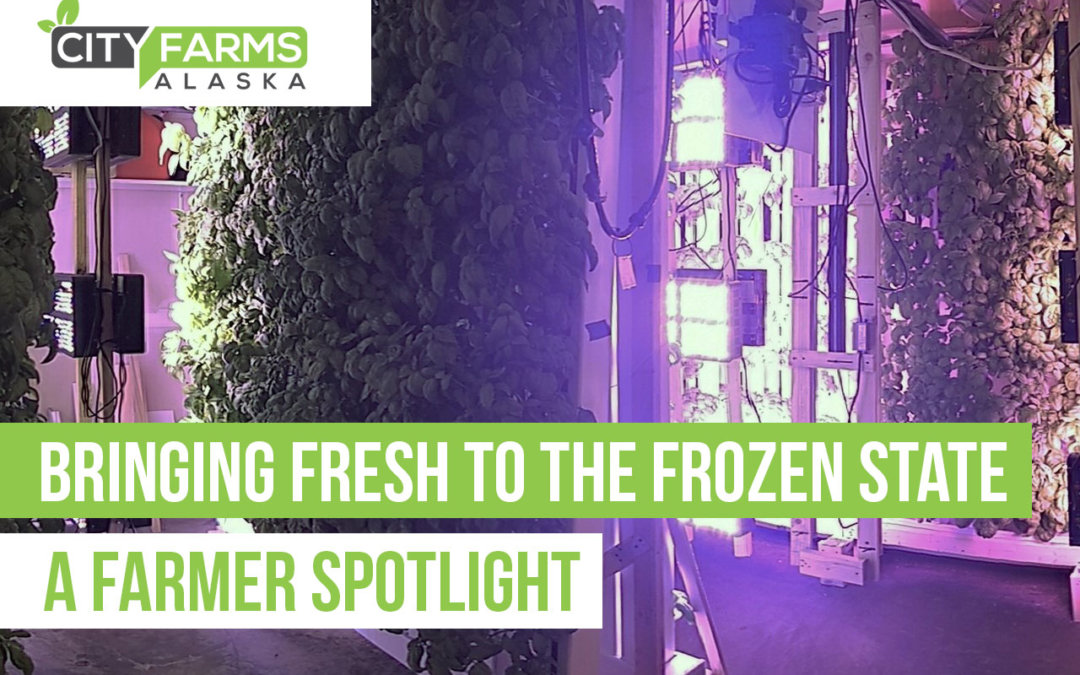A modern farmer’s call to fresh food
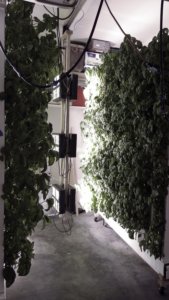
In a repurposed car garage, somewhere in Anchorage, Alaska, there is an indoor farm built from an unexpected combination of rectangular towers held in long, wooden racks.
The farm is CityFarms Alaska, and it’s six months old. It was born for the purpose of serving the Anchorage community with fresh herbs, something that the residents of Alaska usually only experience for 2 or 3 months of the year.
For the rest of the year, much of Alaska’s food system relies on barges and planes that bring produce from the lower 48 states. If the shipment can’t make it, shelves are left empty.
When the shipment does arrive, it delivers less-than-desirable produce; fruits and vegetables that have traveled thousands of miles. By the time they reach the table, they are days if not weeks old, are stemmy, and have bland flavor.
And it’s not just the small urban areas that feel the effects of the tedious shipping process—the large cities of Alaska share the dependency on imported foods due to the short growing season and long winters among a long list of other limiting factors¹. In addition, the state has been inclined to focus more effort on producing valuable exports, like oil, than on sustaining viable food systems. In short, fresh foods in Alaska is an accessibility game, and Alaska was dealt a bad hand.
The process of rebuilding
To solve that problem and other food security issues around the world, many farmers, like those in the Upstart University community, are implementing modern sustainable methods in and around cities to reduce the amount of time and distance produce travels, and to increase the quality.
The garage farm is one of many to join the movement that aims to rebuild the foundation of the food systems in America and across the world. CityFarms Alaska is an up-and-coming modern agriculture solution to the shortage of fresh in the 49th state.
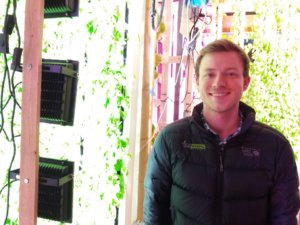 Nik Bouman, the founder of CityFarms Alaska, was an unlikely candidate for starting a farm. Having attended college for an education in business and finance, he always knew he wanted to start a business of his own. He had no idea it would be farming.
Nik Bouman, the founder of CityFarms Alaska, was an unlikely candidate for starting a farm. Having attended college for an education in business and finance, he always knew he wanted to start a business of his own. He had no idea it would be farming.
Naturally, there were some knowledge gaps to fill. When asked about the ways he overcame those experience gaps, Nik said that the most valuable resources by far were Upstart University and YouTube videos featuring Dr. Nate Storey.
Like so many great experiments, Nik’s began in his basement while he was a student in Oregon. It was a small hobby system, nothing more than a few Towers on the wall. It wasn’t until he moved back to Alaska that he invested in a system that could support a commercial yield. “Before, it was just me in a basement with a few heads of lettuce and some basil,” he recalls.
Intrigued by the innovation opportunities of a fairly young industry, he found that he enjoyed farming, but was frustrated by the crop limitations of the towers. He knew his small system was a means to an end—kale, parsley, and chives would all come in time—so he made the most of it by learning as much as he could from it.
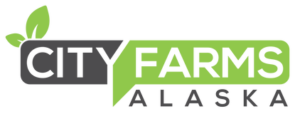
Nik ended up appreciating the small beginning, as the risks and mistakes yielded less expensive consequences. With this in mind, he built out the commercial farm in his garage, mimicking a large farm as closely as his budget would allow.
The farm holds fifty seven-foot ZipGrow Towers, arranged in wooden racks that Nik handmade. Each Tower bursts with verdant growth; sweet basil, Thai basil, and lemon basil, varieties that have so far had the best yield as well as profit.
Someday, he says, he hopes to bring fresh tomatoes and even strawberries to the last frontier. Luckily, the market is brimming with potential for locally grown fruits with reliable availability.
Rising to the local need
At only six months old, the farm is already producing enough to be sold in the local Anchorage grocery stores. He provides recognizable value to his customers by using the Alaska Grown logo on his custom display.
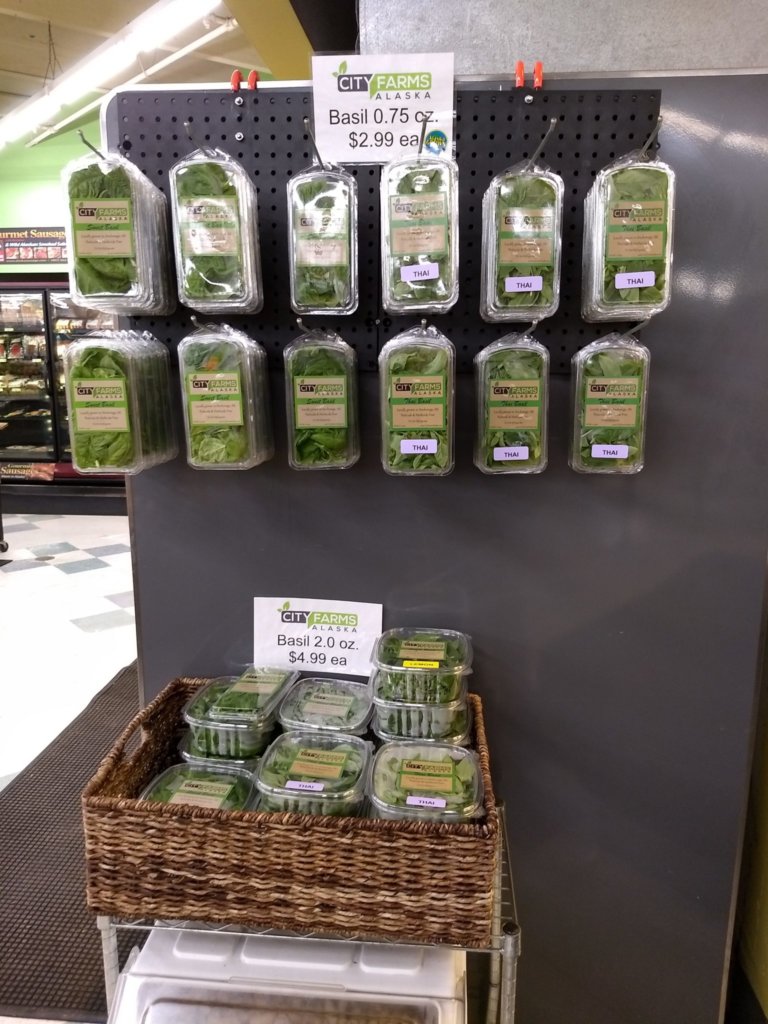
CityFarms Alaska clamshells hang from custom displays under signs that proudly boast the “Alaska Grown” logo.
Alaska Grown is a program developed by the agriculture industry in the state to bring awareness to consumers regarding products grown regionally. It encourages growers to use the logo, but only on produce that is 100% local².
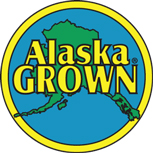
Nik’s basil is among the 4% of food that is grown locally in the state of Alaska, a number that increased in recent years³. Most produce grown in the state is available for only three months, and from November to April, the state relies on storage and imports.
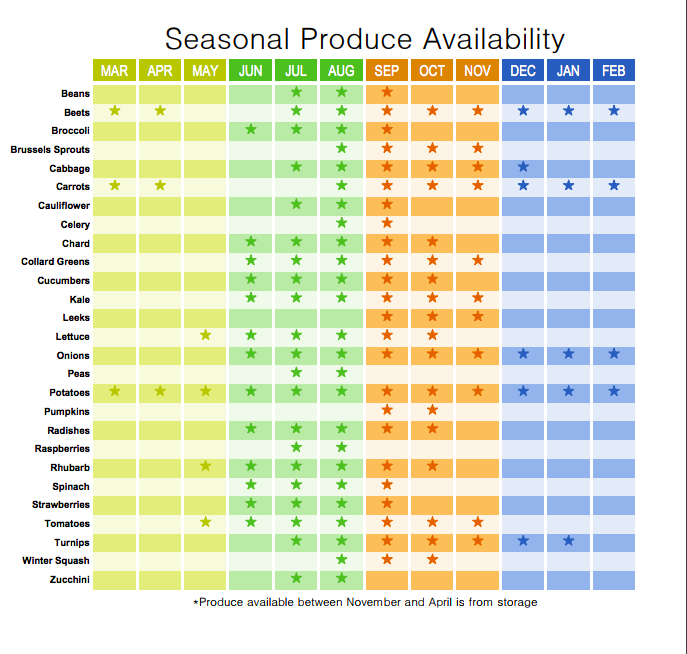
“Seasonal Produce Availability.” http://dnr.alaska.gov/ag/sourcebook/2014SBimages/Seasonalproduce.pdf
Nik produces year round. “People really care about local up here, and there’s hardly any of it,” he says. Thus, the value and potential of controlled environment agriculture have been recognized as a viable approach—if not solution.
Because local products are currently so hard to find, entering grocery stores was fairly easy for Nik. It was also a more profitable option than restaurants, who were more concerned about price than about quality. In addition to inconsistent availability, quality and flavor are a common complaint of locals. Nik’s superior quality has been a huge selling point for the basil. The flavor of something that was harvested just a few hours ago is hugely different from the conventional product harvested a week ago.
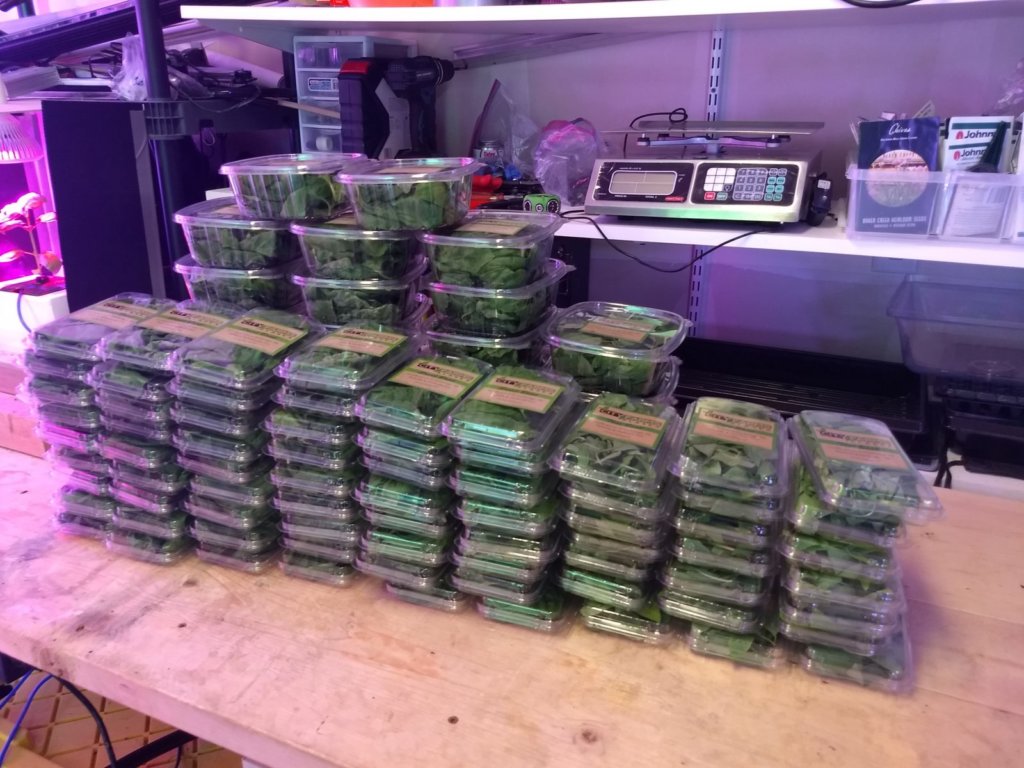
Nik saw the opportunity for innovation and novelty in the indoor agriculture industry and jumped on the chance to combine his dream of owning a business with helping to solve the struggling Alaskan food system. He came to understand that the satisfaction of providing his community with high-quality freshness gave way to owning a business he is proud of.
See Nik’s farm in action at the CityFarms Alaska website, and follow the farm on the CityFarms Alaska Facebook page.
Would you like to have your farm featured on Upstart University?
Contact us by reaching out to support@upstartuniversity.net!
- ¹ Phu, Lisa. “Alaska only grows 4 percent of its food. Can we do better?” JuneauEmpire, http://juneauempire.com/local/2016-09-08/alaska-only-grows-4-percent-its-food-can-we-do-better
- ² Alaska Department of Natural Resources. “Alaska Grown Program.” Division of Agriculture, http://dnr.alaska.gov/ag/ag_AKGrown.htm
- ³ Phu, Lisa. “Alaska only grows 4 percent of its food. Can we do better?” JuneauEmpire, http://juneauempire.com/local/2016-09-08/alaska-only-grows-4-percent-its-food-can-we-do-better
- ⁴ Alaska Department of Natural Resources. “Seasonal Produce Availability.” Divisio of Agriculture, http://dnr.alaska.gov/ag/sourcebook/2014SBimages/Seasonalproduce.pdf

